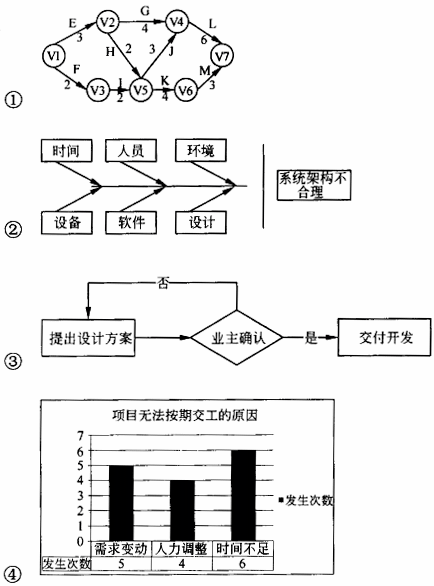在质量管理中可使用下列各图作为管理工具,这4种图按顺序号从小到大依次是()
A.相互关系图、控制图、流程图、排列图
B.网络活动图、因果图、流程图、直方图
C.网络活动图、因果图、过程决策程序图、直方图
D.相互关系图、控制图、过程决策程序图、排列图
参考答案:B
解析:图①为活动网络图法,又称箭条图法、矢线图法,是网络图在质量管理中的应用。活动网络图法用箭线表示活动,活动之间用节点(称作"事件")连接,表示"结束--开始"关系,可以用虚工作线表示活动间的逻辑关系。每个活动必须用唯一的紧前事件和唯一的紧后事件描述;紧前事件编号要小于紧后事件编号:每一个事件必须有唯一的事件号。它是计划评审法在质量管理中的具体运用,使质量管理的计划安排具有时间进度内容的一种方法。它有利于从全局出发,统筹安排,抓住关键线路,集中力量,按时或提前完成计划。图②为因果图,又叫因果分析图、石川图或鱼刺图。因果图直观地反映了影响项目的各种潜在原因或结果及其构成因素同各种可能出现的问题之间的关系。因果图法是全世界广泛采用的一项技术。该技术首先确定结果(质量问题),然后分析造成这种结果的原因。每个"刺"都代表着可能的差错原因,用于查明质量问题的可能所在和设立相应检验点。它可以帮助项目组事先估计可能会发生哪些质量问题,然后,制定解决这些问题的途径和方法。图③展示了从设计到开发的流程,该流程图体现了设计评审需经业主确认,业主同意后才能交付开发。图④是直方图。直方图/柱形图指一种横道图,可反映各变量的分布。每一栏代表一个问题或情况的一个特征或属性。每个栏的高度代表该种特征或属性出现的相对频率。因此B是正确答案。
